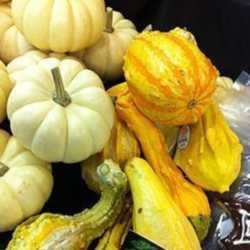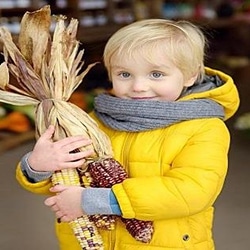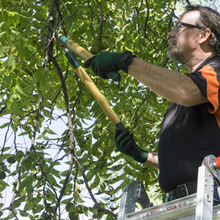If you live in the "Corn Belt" of the United States, chances are you've heard of the practice of detasseling corn. In this day of chemical treatments and automated and mechanical advances, it may seem odd that there are still crews of teens and adults that tread up and down every row of a field of corn, manually removing the tassels. I know it was a common summer job when I was a teenager, and it is still necessary all these years later. My son is in the midst of his second summer of detasseling.
To understand the practice of detasseling corn, you must first understand the basic parts of the corn plant, and how they affect the production of the corn ears. Once you understand how the kernels are formed, you can understand why it is necessary to remove the tassels from seed corn.
 A corn plant (zea mays), also known as maize worldwide, is a type of large grain. It is made up of a central stalk, with wide, grass-like leaves that extend on every side of the stalk. These stalks can reach 8-10 feet in height, occasionally more, which is surprising to me when I examine how shallow the root structure is. Unlike tall plants that develop a long tap root, corn has fairly shallow, fingerlike roots. Often the top of the roots is visible above the soil line, and you can see the many branching "fingers" extending down into the soil.
A corn plant (zea mays), also known as maize worldwide, is a type of large grain. It is made up of a central stalk, with wide, grass-like leaves that extend on every side of the stalk. These stalks can reach 8-10 feet in height, occasionally more, which is surprising to me when I examine how shallow the root structure is. Unlike tall plants that develop a long tap root, corn has fairly shallow, fingerlike roots. Often the top of the roots is visible above the soil line, and you can see the many branching "fingers" extending down into the soil.
 Each stalk may form one to three ears of corn, which contain the seeds or grains. These are commonly known as kernels. The kernels form in orderly rows along the length of the cob, and are enclosed in layers of leaves called husks. As many as 500-600 kernels form on each ear of corn, and range widely in color from white or yellow, to reds, browns, and blacks. Most field corn or seed corn, however, is yellow. Each ear has a cluster of hair-like stigmas called silks that extend from the kernels, out the top of the husks.
Each stalk may form one to three ears of corn, which contain the seeds or grains. These are commonly known as kernels. The kernels form in orderly rows along the length of the cob, and are enclosed in layers of leaves called husks. As many as 500-600 kernels form on each ear of corn, and range widely in color from white or yellow, to reds, browns, and blacks. Most field corn or seed corn, however, is yellow. Each ear has a cluster of hair-like stigmas called silks that extend from the kernels, out the top of the husks.
 At the very top of the stalk, tassels form. These are the "male" part of the corn stalk, literally the flower of the stalk, and produce pollen. This pollen is distributed by wind, though it tends to fall within a yard or two of the parent plant. People with corn allergies are often miserable during the pollination period, as the air is filled with a haze of corn pollen. It does make for some spectacular sunsets, though!
At the very top of the stalk, tassels form. These are the "male" part of the corn stalk, literally the flower of the stalk, and produce pollen. This pollen is distributed by wind, though it tends to fall within a yard or two of the parent plant. People with corn allergies are often miserable during the pollination period, as the air is filled with a haze of corn pollen. It does make for some spectacular sunsets, though!
 The pollen falls from the tassels onto the hair-like silks that grow from the top tip of every ear. Each silken hair leads to a potential kernel on the immature ear of corn. If the silk is pollinated, the portion that is exposed outside of the husk turns brown, and a kernel forms. If it is not, that kernel remains unformed. If you have seen an incompletely formed ear of corn, with gaps and areas toward the tip with no kernels, you've seen the result of incompletely pollinated corn. As annoying as those silks may be on the sweet corn you are eating, they play an integral role in forming the kernels you are enjoying, slathered in butter. While the picture here shows bi-color sweet corn, with a higher sugar content to make it palatable to humans (and raccoons!), the same process is true of field corn and seed corn.
The pollen falls from the tassels onto the hair-like silks that grow from the top tip of every ear. Each silken hair leads to a potential kernel on the immature ear of corn. If the silk is pollinated, the portion that is exposed outside of the husk turns brown, and a kernel forms. If it is not, that kernel remains unformed. If you have seen an incompletely formed ear of corn, with gaps and areas toward the tip with no kernels, you've seen the result of incompletely pollinated corn. As annoying as those silks may be on the sweet corn you are eating, they play an integral role in forming the kernels you are enjoying, slathered in butter. While the picture here shows bi-color sweet corn, with a higher sugar content to make it palatable to humans (and raccoons!), the same process is true of field corn and seed corn.
Field corn, especially that destined for use as seed corn for next year, is a little different. Most seed corn sold is a hybrid variety, meaning that two different parent plants were used in production of the corn kernels. A field planted with hybridized corn may yield double or triple the number of bushels of self-pollinated varieties. Understandably, farmers want to gain the maximum yield from their fields, as they are paid by the bushel harvested. In order to produce these hybrid seeds, the seed corn companies plant two varieties and forced them to cross-pollinate. Seed producers may plant one variety known for high production, and another known for disease resistance.
The hybridization begins at planting time. The seed is planted in something called panels or blocks, with 4-6 rows of the corn that will bear ears, known as the "female" rows (though literally, all stalks have both male and female components), and then 1-2 rows of the corn that will be used to pollinate the crops, known as the "male" rows. A buffer zone of all-male rows are planted all around the perimeter of the field, as well, to prevent pollen from blowing in from neighboring fields. As the wind blows and shakes the pollen loose from the "male rows," it will travel several yards to pollinate the nearby "female rows," creating hybrid seed corn that bears the characteristics of both parent varieties. The seed from these female rows is allowed to mature and dry on the stalk, and is then harvested and sold to farmers the following year to produce their crops.
Unfortunately, the hybridization process does not allow the farmer to save seed from his own crops to replant the following year. The hybrids do not pass on their vigor or disease resistance to their offspring, so farmers must buy new hybrid seed each year from the seed companies. Old open-pollinated varieties allow the farmer to save and replant his own seed, but do not offer the disease and insect resistance and high yields of the hybrids, known as "hybrid vigor."
 Both varieties are allowed to grow undisturbed early in the season. Once the tassels begin to form, however, it is time to take action! Usually, a machine first goes through the fields, cutting the tops of the leaves off and pullling the tassels off the "female" rows. These machines will remove perhaps 70-80% of the tassels, but because of the variation in height between individual stalks, and slight variation in maturity time, there are still many tassels left in the field. In order to be sold as pure seed, more than 99% of the tassels must be removed. This is where manual detasseling comes in. The picture to the left shows a field with most of the tassels removed from the female rows. If you look closely, you can even see a few detasselers scattered throughout the field.
Both varieties are allowed to grow undisturbed early in the season. Once the tassels begin to form, however, it is time to take action! Usually, a machine first goes through the fields, cutting the tops of the leaves off and pullling the tassels off the "female" rows. These machines will remove perhaps 70-80% of the tassels, but because of the variation in height between individual stalks, and slight variation in maturity time, there are still many tassels left in the field. In order to be sold as pure seed, more than 99% of the tassels must be removed. This is where manual detasseling comes in. The picture to the left shows a field with most of the tassels removed from the female rows. If you look closely, you can even see a few detasselers scattered throughout the field.
Most often, it is seed corn companies that contract detasseling crews to come to their fields. They are producing the hybrid seeds that will be sold to farmers the following year. Individual farmers who are producing field corn for use as ethanol, human food products (such as all that high fructose corn syrup we read so much about!), animal feed, etc., are less likely to hire detasselers. In my area, most detasseling is done by crews of teenagers and young adults, some as young as 12 years old. In other areas, crews of migrant workers may be hired.
Detasselers rise early, before dawn, and are transported to the fields. The fields are often muddy and wet with dew early in the morning. As the day progresses, and the temperature increases, the dew burns off and the corn seems to radiate its own heat. The humidity level in a field of corn feels higher than the general humidity level of the air on any given day, as the corn leaves allow moisture to travel from their roots to their leaves, where it evaporates into the air in a process called transpiration. If an area is experiencing drought or excessive heat, the leaves become more upright, held closely to the central stalk, and curl slightly in an effort to retain what moisture they are able to procure.
It is hard, hot work. I think one of the greatest challenges for my teenaged son is getting up at 4:30 in the morning to eat and be ready for the bus by 5:20. Detaselling crews begin early, usually around 6 a.m. by the time the bus has made several stops to pick up workers, in order to get a good day's work in before the most intense heat of mid-day arrives. They must be prepared to work in temperatures ranging from early morning damp and chilly air in the 50-60 degree range, to temperatures above 100 degrees, all within the span of a few hours. Most days, they return home in the early afternoon, having worked 6-8 hours.
My son has perfected his detasseling gear: he wears quick-dry pants, rather than jeans, so they don't become heavy from the dew or chafe his skin from prolonged moisture. He wears a very lightweight quick-dry shirt, either a long-sleeved t-shirt style or a button-up shirt, with built in SPF to help protect him from the hours in the hot sun. It may seem odd to wear long sleeves in 90-100 degree heat, but this lightweight layer protects him from the dreaded "corn cuts" that workers get from walking between closely planted rows. Imagine a paper cut, but deeper, with sweat running into it to make it burn. He wears a hat with a brim and a mosquito net over his face, and lightweight gloves. Very little skin is exposed to either the sun or the slicing corn leaves.
Detasselers are required to bring at least a gallon of water, in addition to a packed lunch. His other two indispensible items are a water hydration system backpack, such as a Camelbak, which allows him to sip hands-free throughout the field, and an industrial-sized bottle of sunscreen! Despite his protective gear and preparation, he still comes home with aching shoulders and back, and blisters on his hands.
Most detasselers work 3-4 weeks a summer, depending on the weather conditions any given year. The window of opportunity for removing the tassels is fairly small: you can't begin until the tassels are forming, but then you must work quickly to remove them before they release their pollen. The detasselers have a deceptively simple job: reach up to the top of the stalk, pull out the tassel, and toss it on the ground. Doing it once is easy. Doing it hundreds of times, raising your arms above your head for hours, can be exhausting. They walk miles of rows each day, removing the tassels from the rows designated "female rows," to prevent them from self-pollinating.
I have a deep appreciation for the farmers that work the land, and am proud that my son has the work ethic and dedication to persist in a job that demands so much physically. I hope this explanation has helped you understand the process of detasseling corn!
Photo Credits:
Images from Flickr Creative Commons and Wikimedia Commons are used in accordance with their respective Terms of Service. Please click on the picture description to see the original image.
In order of appearance:
Thumbnail image of rows of corn: Flickr Creative Commons, submitted by tikarasha. Some Rights Reserved.
Corn Roots: Flickr Creative Commons, submitted by kkfea. Some Rights Reserved.
Corn Silks: Wikimedia Commons, submitted by Pollinator.
Corn Tassels: Flickr Creative Commons, submitted by wattpublishing. Some Rights Reserved.
Ears of Corn with husks and silks: Flickr Creative Commons, submitted by photofarmer. Some Rights Reserved.
Field of corn being detasseled: Wikimedia Commons, by Flip Schulke with the National Archives and Records Administration.
















